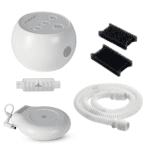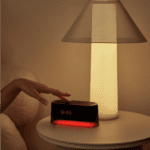Since sleeping aids human growth and development, a baby’s sleep is a high priority for parents and caregivers. Sleep is also important for adults, who should get at least 7 hours per night, which can be challenging when caring for a baby.
Sleep training can help your baby develop healthy sleep patterns and self-soothing behaviors during nighttime wakings. By reducing nighttime disruptions, sleep training a baby can also help parents get the recommended amount of sleep each night.
Top 5 Sleep Training Tips

- 1 Let the baby cry-it-out and fall back to sleep on their own.
- 2 Take your time checking on the baby through controlled crying.
- 3 Camp out in the baby’s room, but do not touch or pick up the baby.
- 4 Fade into a desired bedtime by slowly changing the baby’s schedule.
- 5 Schedule awakenings shortly before the baby would naturally wake up.
Parents and caregivers should keep in mind that babies do not usually develop stable sleep cycles until they are 3 months old.
What Is Sleep Training?
Sleep training is a method that teaches a baby to self-soothe and go back to sleep at night without parental intervention. Sleep training can help establish a sleep routine so that both the baby and their parents get the right amount of sleep.
When to Start Sleep Training
Sleep training can begin once a baby reaches 6 months of age. Before that, babies may sleep up to 18 hours a day and their sleep is often fragmented because they have not yet developed a circadian rhythm, which helps a person differentiate between day and night. Research does not support sleep training during the first 6 months of a baby’s life.
What Are The Benefits of Sleep Training?
Research shows sleep training can improve a baby’s sleep and their mother’s emotional well-being by decreasing the number of nighttime awakenings a baby experiences. Similarly, one study found that fathers’ moods and sleep quality suffered when their infants slept poorly. Parents who practice sleep training experience less fatigue, better sleep, and more positive moods.
Shop the Best Crib MattressesHow to Sleep Train Your Baby
Researchers have found multiple sleep training methods to be successful.
Cry-It-Out Method
The cry-it-out sleep training method involves allowing a baby to lie in their crib and cry themselves to sleep when they wake up during the night rather than picking them up to soothe them. Research suggests that, over time, babies begin crying less often after they have been left to cry it out. Crying it out is considered a behavioral extinction method, since the unwanted behavior of crying ceases once it is no longer reinforced by a parent coming into the room.
Some parents find the cry-it-out method difficult to follow, because they feel stressed or upset if they don’t respond to their child’s cries. The cry-it-out method is controversial among parents and experts alike. Multiple research studies suggest that the cry-it-out method does no harm. However, other researchers argue that crying it out can cause both attachment and developmental issues in infants.
Controlled Crying
The initial cry-it-out method required a parent to ignore all crying, unless a child was sick or hurting. With time, more parents began doing a graduated cry-it-out, or controlled crying, in which they ignored crying some, but not all, of the time. Controlled crying involves ignoring a baby’s cries for certain time periods and gradually increasing the lengths of those time periods. Controlled crying and crying it out appear to be similarly effective, but controlled crying might be less stressful for parents.
Some call controlled crying “the Ferber method,” because doctor and researcher Richard Ferber was an early proponent of this sleep training method. In a bestselling book on sleep training, Ferber outlined a specific chart detailing how long, over the course of a week, parents should allow their baby to cry each time they wake up at night.
Camping Out Method
The camping out method is similar to cry-it-out in that it is a behavioral extinction method. Some parents might find this method is easier than cry-it-out, since camping out allows parents to enter their baby’s room in response to cries.
When practicing this method, a parent “camps out” in their baby’s bedroom in response to crying, but generally talks very little and does not pick the baby up. Their presence in the room helps soothe the baby. With time, they stay farther away from the baby’s bed when the baby wakes, until eventually, their presence is not needed to help the baby fall back asleep. One older study found that over half of parents who tried this method found it helpful.
Bedtime Fading
Bedtime fading, also called sleep fading, occurs when a parent puts the child to sleep progressively earlier or later each night until they reach a desired bedtime. Bedtime fading is associated with decreased nighttime wakings and decreased parental stress.
Scheduled Awakenings
When practicing the scheduled awakenings sleep training method, parents wake up their baby throughout the night right before the baby would normally wake up, in order to preemptively soothe them. Older research shows scheduled awakenings led to less crying during the night. But this method may be more difficult for parents, as it requires the child to wake up at the same time each night. It also disrupts parental sleep routines.
Consistency Helps Your Baby Sleep Through the Night
Incorporating a sleep training method is not the only way to help babies sleep through the night. Maintaining a bedtime routine and consistent sleep schedule can also help your baby sleep better.
Research suggests that putting your baby to sleep at the same time each night can lead to increased sleep and less variability in sleep patterns. A bedtime routine carried out at the same time each night can help maintain a consistent sleep schedule. Bedtime routines have been found to benefit babies by improving their sleep and family functioning. One group of researchers recommends beginning the bedtime routine prior to 9 p.m. each night and carrying it out at least 5 nights per week.
Try incorporating these activities into a baby’s bedtime routine:
- Reading or telling a story
- Taking a bath or warm shower and brushing teeth
- Singing a lullaby or listening to calming music
- Breastfeeding or giving a healthy snack
- Cuddling, rocking, or massaging
References
The Sleep Doctor Forum: Real Experiences, Real Connections
Continue the discussion on the Sleep Doctor Forum. Connect with experts and fellow forum members on CPAP, sleep apnea, and all things sleep. A priceless resource that’s free to join.








































